Paid content by Polyplastics Co., Ltd.
Polyacetal (POM) is a well-known, crystalline-structured engineering plastic that has excellent friction and wear resistance. The greaseless POM concept began when suppliers for applications such as food-grade conveyor chains, mechanical cassette deck systems and printer components demanded a new formulation to eliminate lubricant migration. As a result, cleaner application operation was developed, which dramatically reduced labor and supply costs for the manual greasing stage of the manufacturing process.
While the first-generation polyacetal material incorporated a special lubricant package that provided excellent performance and high sliding success for one specific purpose, it failed to provide strong molding stability.
The second generation accommodated multi-usage purposes to increase the molding stability performance, which was developed by combining lubricants along with other enhancement packages. The new functions allowed for good affinity between the lubricants and the POM polymer to further improve the sliding properties of the material.
However, it was difficult to apply the second-generation POM to several common automotive applications, such as window lifting systems, actuator gears and HVAC components, due to the severe load and sliding conditions. Automotive contaminants, including dust, road salt, chemicals and others, are more abrasive. Therefore, a new generation of greaseless, high-sliding POM was developed to accommodate harsher demands. See Figure 1 for a visual representation.
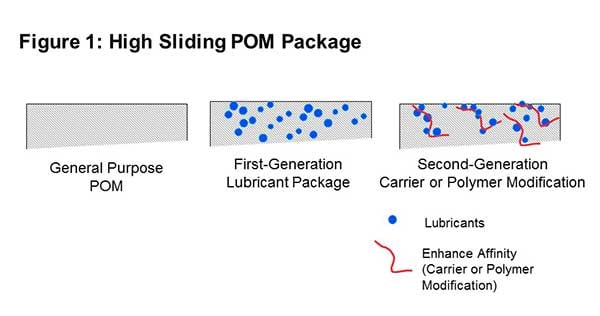
As time progressed, several formulations of polyacetal were developed for various sliding purposes, resulting in a number of unique advantages. Table 1 below illustrates common types of POM damage for sliding applications, including pitting, adhesion and abrasion.
- Pitting fatigue is caused by cyclic compression, which is observed on roller surfaces and lubricated POM gears.
- Adhesion is usually found on bearings, gearing structures and cam systems that have high-speed or high-load conditions, leading to surface separation during operation. The heat generated by the friction negatively affects the performance of the part directly. Generally, a low-friction alternative is a good counter measure to enhance the sliding performance.
- Abrasion is a shaving or filed damage caused by hard edges and rough surfaces. Because frictional heat might not affect the material as severely as adhesion, enhancing toughness and durability is one of the most important factors in counteracting frictional damage.
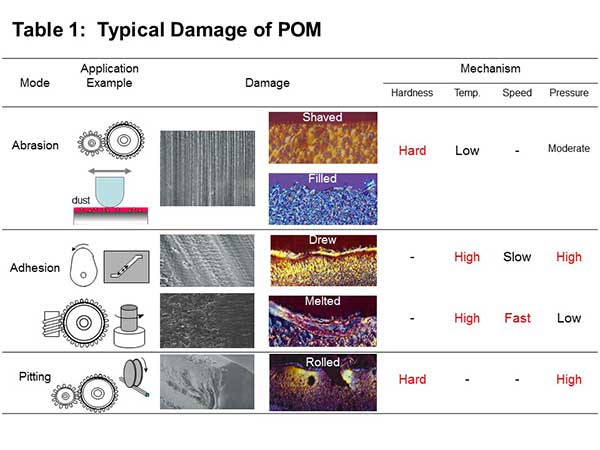
The latest generation of high-sliding POM targets equipment, including window-lifting systems, door checkers and sunroof sliding systems, exposed to outside elements such as dust. As illustrated in Figure 2 below, abrasion not only increases wear, it also generates excessive noise – especially with POM – as particles may fall on mating surfaces leading to sharp, high-pitched noises.
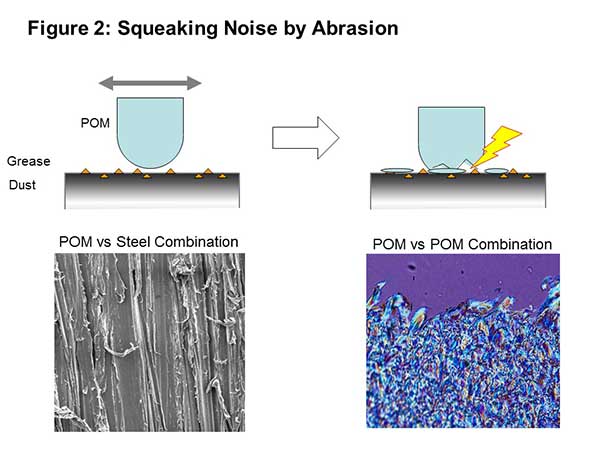
To ensure proper resistance to abrasion and noise, it is critical to consider formulations developed specifically for high-sliding polyacetal materials that are also exposed to outside elements. The squeaking noise is generated when the two material surfaces rub together during operation, which cause micro-vibrations. To avoid this, the friction coefficient should be increased as frictional speed increases.
Illustrated in Figure 3, the difference between the static friction coefficient (μs) and the dynamic coefficient (μd) can be seen using a squeaking index. Overall, materials that have a lower squeaking index can reduce the risk of noise.
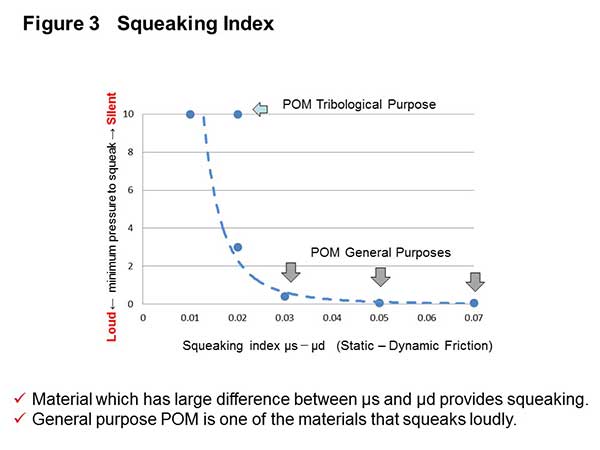
Both abrasion and the noise associated with it are connected to the mating surface type and dust conditions. “Arizona dust” is a well-known type of dust used for POM abrasion testing in the United States, while “China dust” is very common for abrasion testing in China. As shown in Figure 4, the latest in high-sliding POM technology provides the lowest abrasion and noise for applications that are exposed to outside elements.
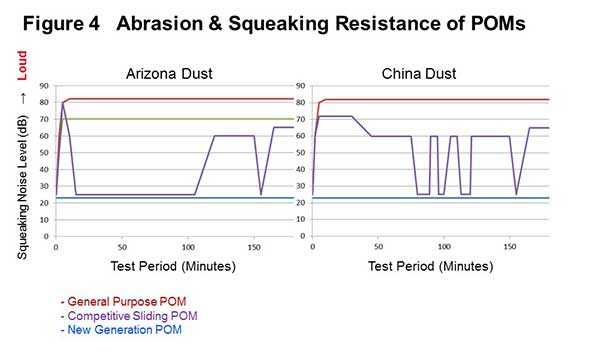
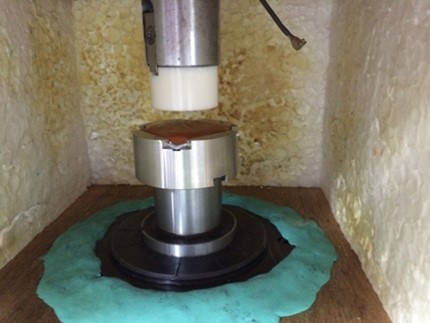
About Polyplastics
Polyplastics is a global leader in the development and production of engineering plastics solutions. With more than 50 years of experience, its technical experts enhance manufacturing and product performance with a proficiency that has become second nature. Backed by a strong global network of R&D, production and sales resources, the team is able to create advanced solutions for an ever-evolving market. For more information, visit our website, www.polyplastics.com/en/.
Contact Polyplastics at americas.info@polyplastics.com and eu.info@polyplastics.com.
The views, opinions and technical analyses presented here are those of the author or advertiser, and are not necessarily those of ULProspector.com or UL Solutions. The appearance of this content in the UL Prospector Knowledge Center does not constitute an endorsement by UL Solutions or its affiliates.
All content is subject to copyright and may not be reproduced without prior authorization from UL Solutions or the content author.
The content has been made available for informational and educational purposes only. While the editors of this site may verify the accuracy of its content from time to time, we assume no responsibility for errors made by the author, editorial staff or any other contributor.
UL Solutions does not make any representations or warranties with respect to the accuracy, applicability, fitness or completeness of the content. UL Solutions does not warrant the performance, effectiveness or applicability of sites listed or linked to in any content.



Leave a Reply or Comment